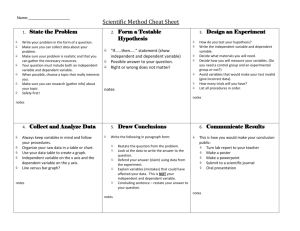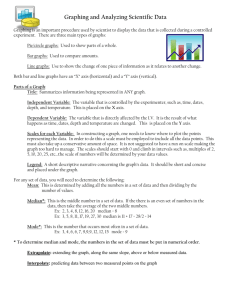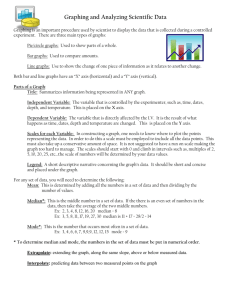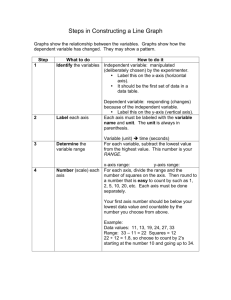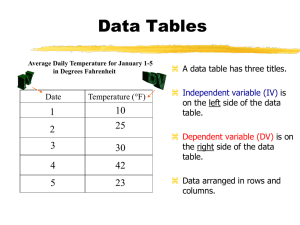notes sheet
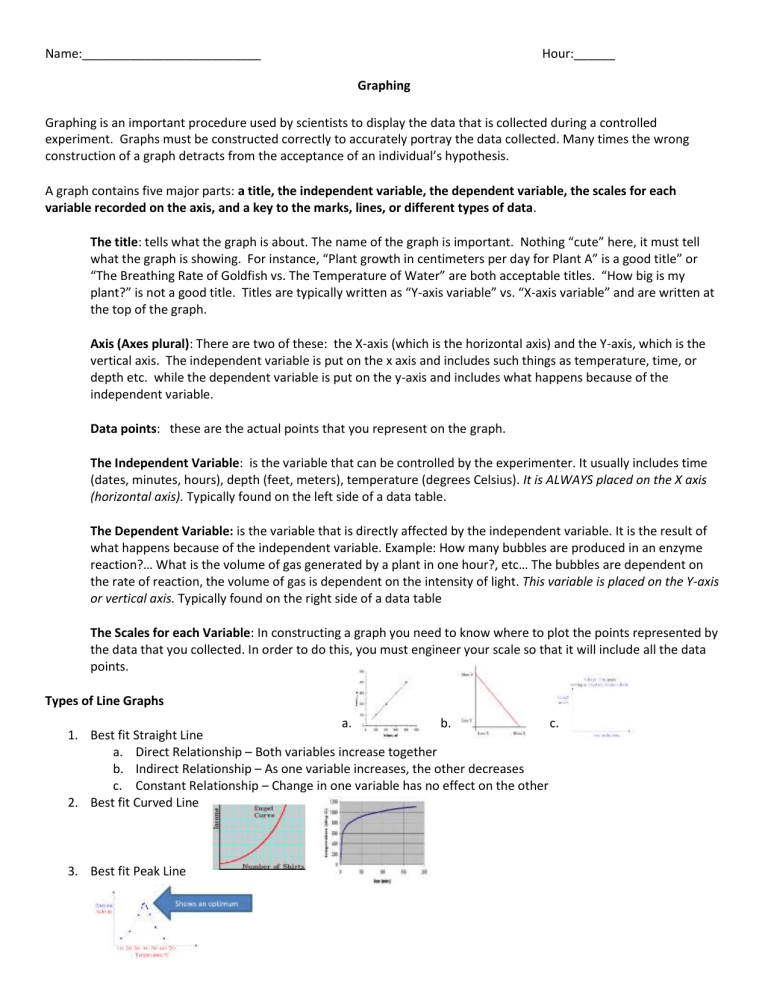
Name:__________________________
Graphing
Hour:______
Graphing is an important procedure used by scientists to display the data that is collected during a controlled experiment. Graphs must be constructed correctly to accurately portray the data collected. Many times the wrong construction of a graph detracts from the acceptance of an individual’s hypothesis.
A graph contains five major parts: a title, the independent variable, the dependent variable, the scales for each
variable recorded on the axis, and a key to the marks, lines, or different types of data.
The title: tells what the graph is about. The name of the graph is important. Nothing “cute” here, it must tell what the graph is showing. For instance, “Plant growth in centimeters per day for Plant A” is a good title” or
“The Breathing Rate of Goldfish vs. The Temperature of Water” are both acceptable titles. “How big is my plant?” is not a good title. Titles are typically written as “Y-axis variable” vs. “X-axis variable” and are written at the top of the graph.
Axis (Axes plural): There are two of these: the X-axis (which is the horizontal axis) and the Y-axis, which is the vertical axis. The independent variable is put on the x axis and includes such things as temperature, time, or depth etc. while the dependent variable is put on the y-axis and includes what happens because of the independent variable.
Data points: these are the actual points that you represent on the graph.
The Independent Variable: is the variable that can be controlled by the experimenter. It usually includes time
(dates, minutes, hours), depth (feet, meters), temperature (degrees Celsius). It is ALWAYS placed on the X axis
(horizontal axis). Typically found on the left side of a data table.
The Dependent Variable: is the variable that is directly affected by the independent variable. It is the result of what happens because of the independent variable. Example: How many bubbles are produced in an enzyme reaction?… What is the volume of gas generated by a plant in one hour?, etc… The bubbles are dependent on the rate of reaction, the volume of gas is dependent on the intensity of light. This variable is placed on the Y-axis
or vertical axis. Typically found on the right side of a data table
The Scales for each Variable: In constructing a graph you need to know where to plot the points represented by the data that you collected. In order to do this, you must engineer your scale so that it will include all the data points.
Types of Line Graphs a. b.
1.
Best fit Straight Line
. a.
Direct Relationship – Both variables increase together b.
Indirect Relationship – As one variable increases, the other decreases c.
Constant Relationship – Change in one variable has no effect on the other
2.
Best fit Curved Line c.
3.
Best fit Peak Line
How to Construct a Graph
1.
Be certain you know what kind of graph you need. Traditionally, line graphs are used in scientific situations, but occasionally we also use pie charts, bar graphs, and sometimes even a histogram. (We will be focusing on
line graphs only)
2.
Identify the variables and label the axes. a.
Independent Variable – factor that is varied in an experiment and specifically controlled by the experimenter i.
Label along the x-axis (horizontal) – include units ii.
Typically found on the left side of a data table b.
Dependent Variable – factor that is measured in an experiment and will change as a result of the independent variable i.
Label along the y-axis (vertical) – include units ii.
Typically found on the right side of a data table
3.
Determine graph scale. a.
Establish a scale that best fits the range of each variable i.
Play the “range game” Find the highest value for your data set and then count the available spaces on the appropriate axis. Think about this one… if you have 30 spaces on your graph and your data goes to 28, you can safely assume that each “box” has a value of “1” for that data set.
However, if you only have 15 spaces, it is safe to assume that each box has a value of “2”.
Practice will help you to understand this. b.
Spread the graph to use the MOST available space (use at least ¾ of the graph) i.
Use the “75% rule” That is, if your graph doesn’t cover nearly 3/4 of the graph paper, take a look at your axes again. In general, the graph should be as large as possible, thus making the data points easy to read. Do not, however, extend your graph beyond the limits of the graph paper provided. c.
Be consistent throughout each axes’ scale
4.
Plot the data points. a.
Plot each data value on the graph with a dot b.
If multiple sets of data are being plotted, use different colored lines and include a key c.
COMMON MISTAKE: Some students think that their points MUST be on a line. This is not true.
Sometimes you need to estimate where the points will fall in between the lines. Putting a point here is fine.
5.
Title the Graph a.
Titles are used to clearly portray what the graph is about so be specific. b.
Titles are typically written as “Y-axis variable” vs. “X-axis variable” and are written at the top of the graph.
